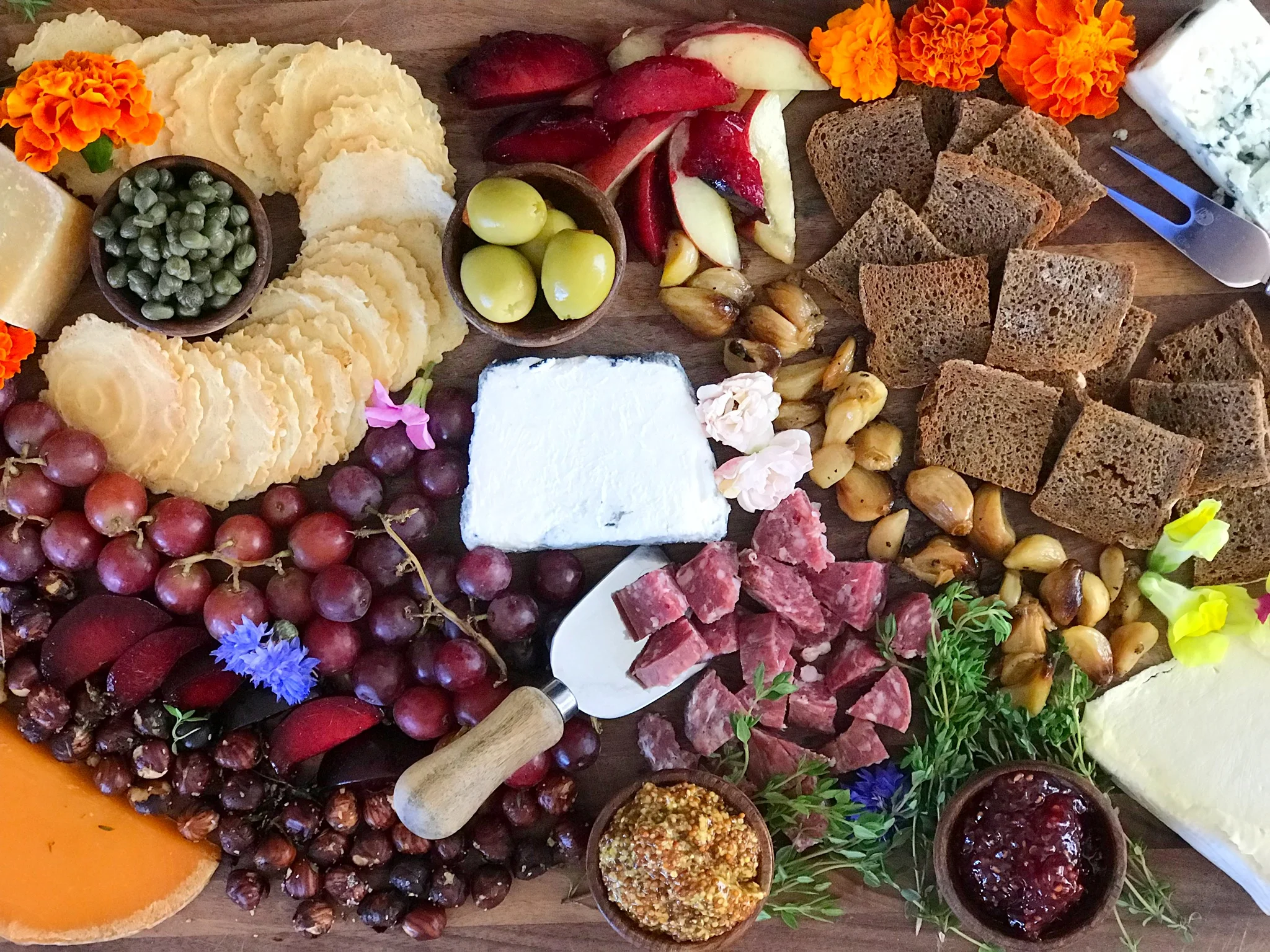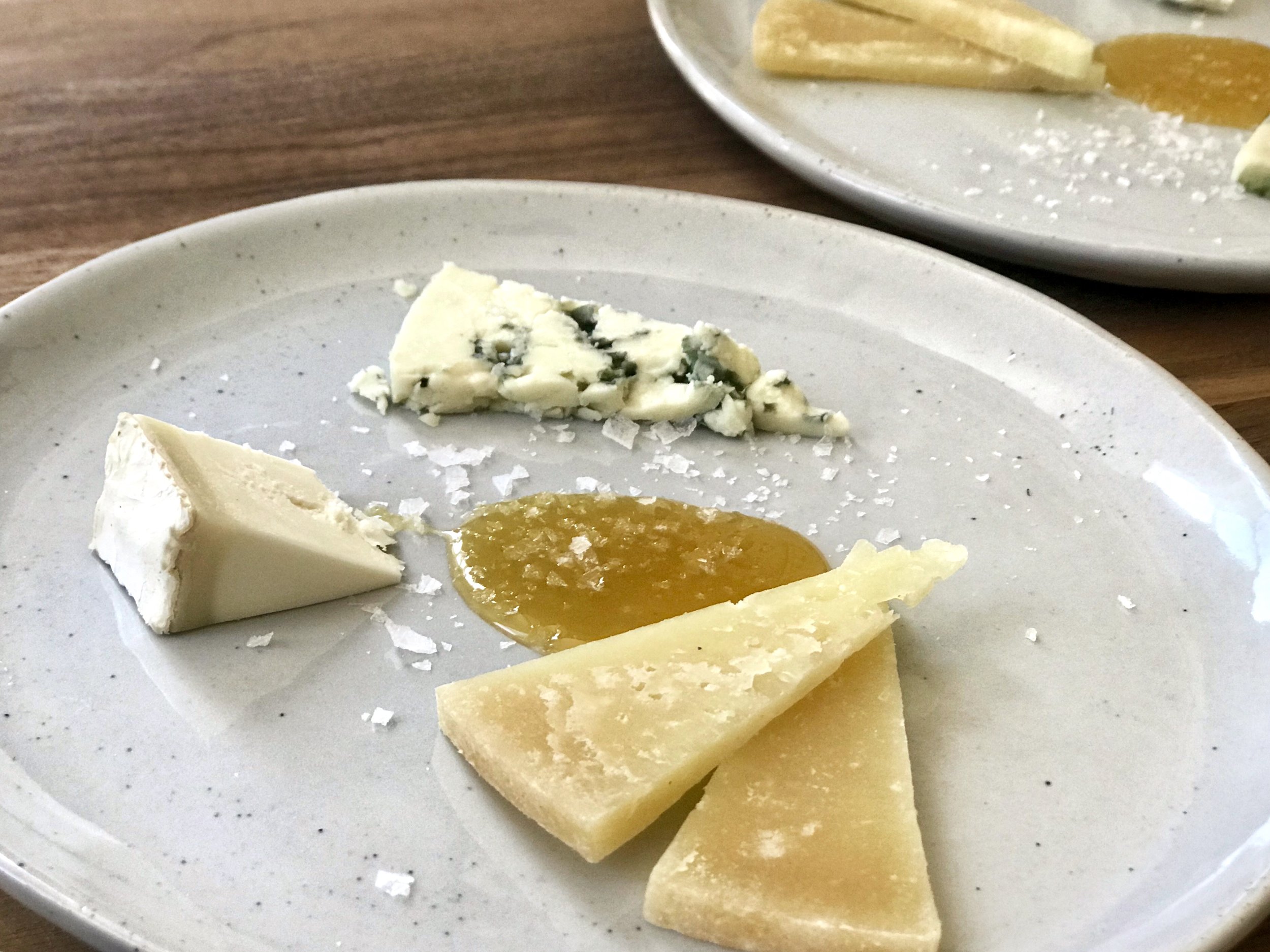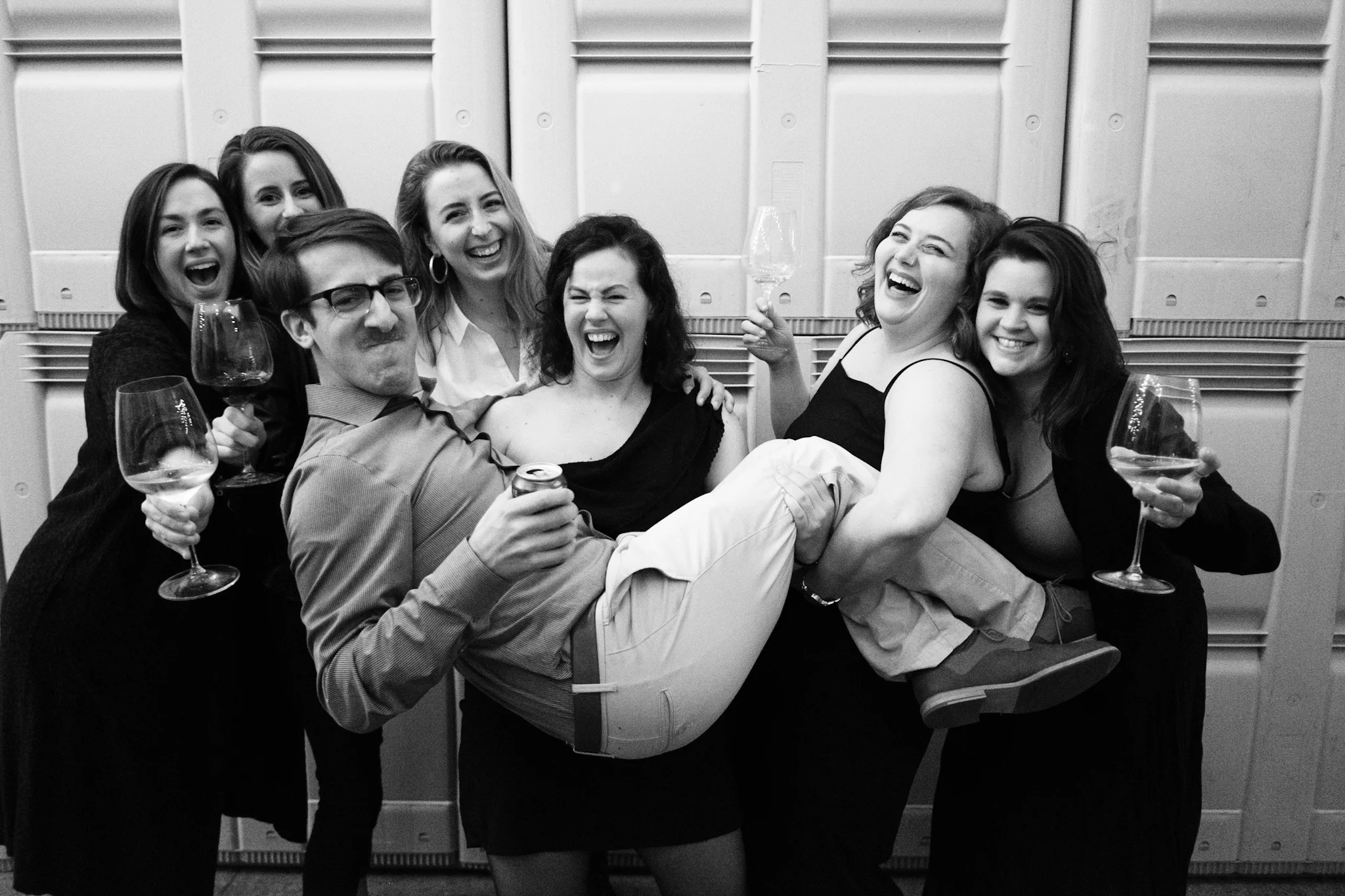Duelling Cheese Plates
Here’s the deal: Your party probably sucks if you don’t serve cheese. (Hey, we don’t make the rules!) People love cheese—there are actual studies that show it's as addictive as drugs—and people want to eat cheese. Whether you’re hosting two, 12, or 20, the ability to craft a delicious, balanced board or plate will be a lifesaver in the long run. We’ve got two foolproof approaches to show you, so buckle up. It’s cheese time.
Craft your own cheese plate
We like to serve cheese one of two ways—either in a bacchanal-style, overflowing board, or an artsy, elegant plate. You can choose which one is better for your event based on budget, what you already have in your pantry, attendance, and personal preference. Either way, people will be happy. Let’s get to it.
Bacchanal-style, overflowing board
Look at this bounty! No host or hostess ever went wrong when serving a big, beautiful board piled high with Europe-y ingredients. This approach is all about abundance—use a variety of colors and textures, and let guests help themselves (with their hands, for a lot of the stuff). Serve with some dope, seasonally-appropriate wine.
The key is this: Fill up every last inch of that board. Cheese, meat, nuts, crackers, fruit, condiments, you name it. Go outside and pick some pretty greens if you have empty space. You want lots of variation in texture and color—the more variation, the fuller it looks.
What’s on this board?
For every overflowing cheeseboard, you need a few key elements: First, cheese. (Don’t forget the cheese.) Also, fruit, meat, nuts, brine, condiments, and pretty garnishes. For this one, we used grapes, apples, and plums; hard salame; rosemary and honey roasted hazelnuts; a handful of olives and capers; roasted garlic cloves (which Dylan likes to call Italian gumdrops); a thin wafer cracker and little rye roasts; grainy mustard, and some fig compote. We also added some pretty green herbs and edible flowers—marigolds and bachelor buttons—for garnish. Get creative with what’s available in your pantry, your garden, and your favorite grocery store.
As for the cheese, here's what we used:
12 month aged Mimolette: This is a cheese from Lille, France that gets its bright orange color from annatto, a natural orange-red dye made from fruit. It's nutty and sweet.
Cana de Cabra: A Spanish bloomy-rind, soft cheese that's creamy and mild with a touch of citrus. Crumbly on the inside, harder on the outside.
Delice de Mon Sire: Like brie, but better. This luscious, buttery, triple-cream hails from Burgundy, France.
Pecorino Toscana. Hard, salty, Tuscan cheese that's totally delicious on a board but also perfect for shaving over pasta and salads. Keep the rind and throw it into your next soup to amp up flavor.
Pave de Jadis. Dylan's favorite cheese. It's covered in ash—not mold—and made in the Loire Valley. It has a killer fudgey texture with bright floral notes.
What’s this gonna cost me?
Though there’s tons of stuff on this board, it can actually be a pretty cheap if you use what’s already in your pantry. Got some walnuts sitting around? Toast ’em up (five minutes in a dry pan) and throw ’em on there. Dijon mustard taking up space on the fridge door? This is a perfect way to finish it off. If you use what you have, you only need to buy the cheese and the meat. More guidance on that below.
How much of each cheese should I buy?
For the bacchanal board, you want big, bountiful hunks of cheese, about four to six ounces of each. That will ensure there's enough to go around. You’ll probably have leftovers, and that is a very good thing.
How do I pick the cheese?
This one’s all about diversity—pick four to six cheeses, each in a different texture, color, and style. There's no wrong way to go here, but if you're looking for a nudge in the right direction, choose one hard, one soft, and one semi-soft. Get one made from goat milk, one from cow milk, and one from sheep milk. If you have no freakin’ idea what to buy, go to a really good cheese counter, tell the cheesemonger you’re making a big, bacchanal-style cheese board, and tell her your budget. She’ll help you pick some cool stuff.
What fruit should I use?
Try for stuff that’s in season—think citrus in winter, apples and pears in fall, and figs and stone fruit in summer. A big pile of grapes looks good all year ’round.
The flowers look so pretty! How do I know what kind of flowers are edible, and where do I get them?
The best way to get edible flowers is to grow them (!), but some specialty food shops sell them. We found these at PCC in Seattle—you could try your local co-op or Whole Foods. A few Pacific Northwest favorites: nasturtium, marigolds, violets, and bachelor buttons.
I don’t have a big cutting board. Am I doomed?
Nope! You could use a platter, or even a big plate. The vehicle doesn’t matter—it’s all about presentation.
What wine should I serve?
Well, this is a much, much larger question. Start with something high acid, as you're pairing it with delicious, fatty cheese. Consider pairing your wine and cheese by region. For example, a Loire Valley Vouvray with Pave de Jadis; a Washington state Rhone blend with Dinah's cheese from Kurtwood Farms; an Italian Langhe Rosso with fontina. When in doubt, drink sparkling wine.
Artsy, elegant plate
This one may seem simpler, but the complexity is in the details. With a big board, you have room for error. This pretty plate only has room for cheese. Delicious, perfectly picked parcels of coagulated milk protein. (Plus a little honey and flaky salt.) Because there is nowhere to hide, your cheese picks have to be flawless. Your honey has to be from a jar, not a plastic bear. Your plates even have to look nice! So, where do you start? We’ll show you.
The key is this: Leave some negative space. Unlike the bacchanal board, minimalism is key. You want tiny slices of cheese, just a dollop of honey, and a sprinkle of flaky salt. Use a monochrome palette, and play with the negative space for a super refined, design-forward presentation.
What’s on this board?
Three cheeses, oh-so carefully chosen, plus a dab of Tasmanian leatherwood honey (Karen’s favorite thing), and some Maldon salt. We used the cheeses listed here, but you can curate your own plate using the tips below.
Soft: Cana De Cabra, goat milk, Murcia, Spain
Semi-soft: Cascadia Glacier Blue Cheese, raw cow milk, Washington, USA
Hard: Pecorino Toscano, sheep milk, Italy
I’m not that into blue cheese. Tell me about this Glacier blue.
Well, it’s an approachable blue with a luxurious texture and deliciously rich flavor. One bite of this masterpiece will wrap your palate in a blanket of salty savor, sink you into the most comfortable chair, and make it clear why PNW locals have coined this "The Gateway Blue.” If you weren’t a blue lover before, this cheese will open that gate and step you through to the other side. Natural rind, aged 75 days. Capiche?
Do I need different types of cheese?
Yes, and this is where the real decision-making comes in. You want to create a holistic plate—the entire world of cheese squeezed into only three specimens on about 0.29 square feet of china. First things first: Choose a theme. Could be texture (soft, semi-soft, hard), animal (goat, cow, sheep), or region (France, Italy, Spain). Pick a theme, and then put one cheese firmly in each category.
For the cheese plate featured here, we decided to focus on texture: soft, semi-soft, and hard. Within that theme, we also went with one blue, to add some intrigue, and we selected one cow, one sheep, and one goat, to mix it up.
How many cheeses should I use?
We like odd numbers. One can be purposeful, three gives options, five feels decadent. For this particular plate, we thought three cheeses worked well.
Looks like you cut the pieces of cheese really small.
True! For a super elegant look, slice each piece of cheese extra-thin, and serve as a pretty triangle. You’ll notice that my softer cheeses kept breaking at the tip, and I did not panic one bit. Cheese is cheese, and this isn’t fine dining—do your best to make it nice, but don’t stress.
How much of each cheese should I buy?
You need about an ounce per cheese per person. So if you’re doing three cheeses for four people, you need four ounces of three types of cheese.
What’s this gonna cost?
Because the elegant approach is all about quality, it can actually be pricier than the bacchanal board, even though it has fewer ingredients. The good news is that it’s low stress—focus on a few nice cheeses, and ask your cheesemonger to help you if you’re clueless. Also, once you invest in nice honey and Maldon salt, they’ll last you for tons of parties to come.
What wine should I serve?
Grower Champagne, or something else wicked classy.
Why do I need fancy honey? That shit is expensive.
You know what, you don’t actually need honey. But, if you’re going to use honey, it better be nice.
The End.













